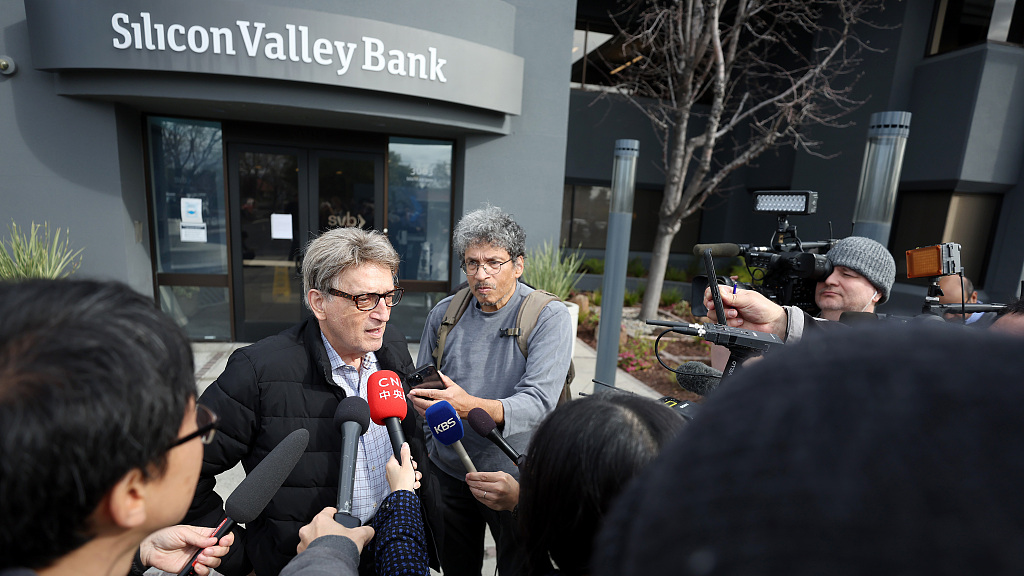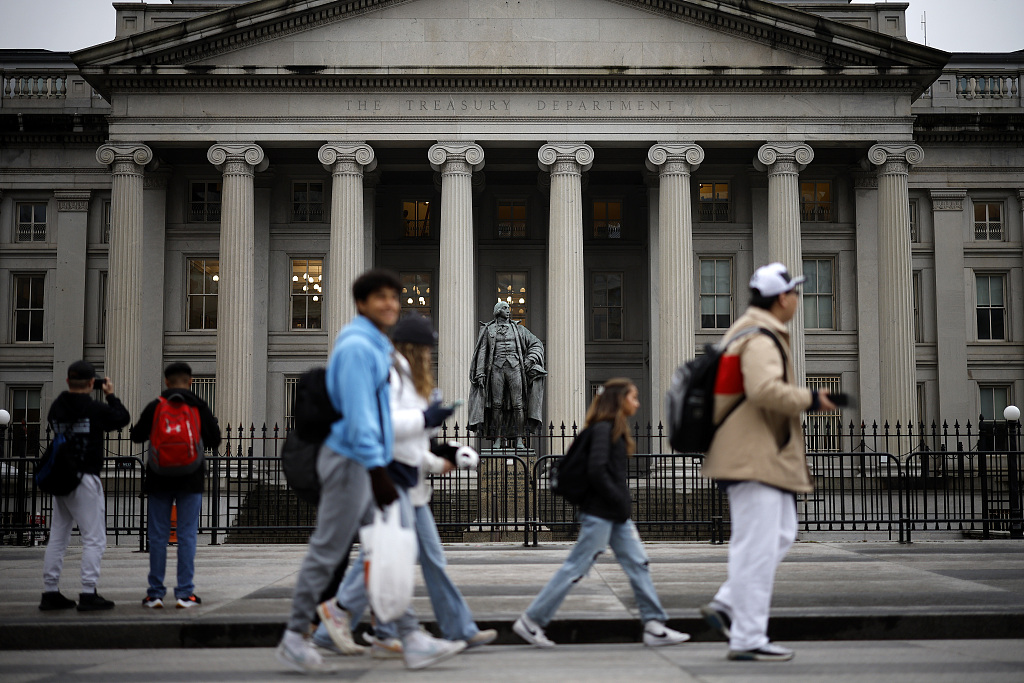
Journalists interview a Silicon Valley Bank customer outside of the bank office in Santa Clara, California, U.S., March 13, 2023. /CFP
Journalists interview a Silicon Valley Bank customer outside of the bank office in Santa Clara, California, U.S., March 13, 2023. /CFP
Editor's note: James Rae is a professor of politics and the director of the Asian Studies Program at California State University, Sacramento. The article reflects the author's opinion, and not necessarily the views of CGTN.
The closure of two banks in the past week, the Silicon Valley Bank and Signature Bank, has raised alarm bells and reminded us of the not too distant memory of the 2008-09 global financial collapse. Already, markets around the world are jittery and stock prices for banks and financial institutions have nosedived.
Does this portend to another shock as was experienced a little over a decade ago? Probably not, but it still reflects the uncertainties of market-based investment decisions and their vulnerabilities to other aspects of the economy.
Here, the closures are symptoms of the highly leveraged and fast-moving technology sector, with its myriad start-up companies hungry for cash to expand and investment bankers and funds seeking the next big thing and outsized returns.
As its name suggests, the Silicon Valley Bank is situated in America's northern California technology hub and made its name by supporting new companies that could not attract investment elsewhere or by branding itself as friendly to such firms. The tech sector has become shakier around the world in the past year or two, making investors nervous. Deposit holders were thus quicker to want to pull out their capital, as they did, leading to a run on the bank's reserves.
Relatedly, the bank itself was conditioned by the past 20 years of operating in a stable, low interest rate environment. Thus, their investment team felt confident in 2021 to purchase longer-term bonds at slightly elevated interest rates, not expecting the dramatic rise in inflation and the cautionary Federal Reserve policy to scale up those basis points over the course of meetings across 2022 in order to tame inflation.

People walk past the U.S. Department of Treasury building in Washington, D.C., U.S., March 13, 2023. /CFP
People walk past the U.S. Department of Treasury building in Washington, D.C., U.S., March 13, 2023. /CFP
The assumption that raising interest rates could both tame inflation and not jeopardize economic expansion is questionable. Each decision has ripple effects, and one of the market costs is that private banks with imperfect knowledge made reasonable but unwise investment decisions. In this case, that has bankrupted the 16th largest bank (holding around $200 billion assets) in the United States, despite the bank's 40-year history of viability.
At this point, no one really knows how vulnerable the private sector banking system is, and whether anything like the 2008-09 financial crisis could reoccur and whether the impact could be global. Therein lies the lesson from the previous contagion, private lending and insuring that lending through private firms is rife for peril. Information may be shared internally among the coterie of persons in the know, but the lack of external transparency perpetuates systemic risk. It thus becomes a test of the public sector regulation by U.S. government watchdogs such as the Securities and Exchange Commission and others.
Definite steps were taken to address previous failings, particularly in the Barack Obama administration. Accordingly, a certain level of confidence prevails that the impact of these bank closures will be limited. President Joe Biden reiterated the importance of these regulations adopted during what he calls the "Obama-Biden administration."
On March 14, Biden reassured the American public and its private investors that "the banking system is safe," and that deposits will be repaid, the Federal Depositary Insurance Corporation will guarantee that through the industry insurance program and that Washington will not need to bailout either bank. Indeed, he asserted that the managers who are responsible should face some accountability ("no one is above the law"), such as losing their job.
The political impact felt in the George W. Bush administration when those responsible still took large bonuses and often kept their jobs would looms large (Silicon Valley Bank had recently paid out their scheduled bonuses). Thus, the issue is also a political one. The Democrats have laid this largely on the door of the Donald Trump administration for reducing some regulatory oversight during the past years, and that may be part of the explanation.
Nevertheless, it does reflect the inherent danger in a market-based investment system where government policy may move counter to the interests of the private sector, even inadvertently (raising interest rates). Meanwhile, private investors must guess and react every few months to a new prime rate that then sets off a volatile stock market and presses consumers and businesses to either spend or save. Since monetary policy is the primary lever in the American economic model, the insularity of the Federal Reserve policymaking process continues to bedevil the broader economy.
In the East Asian economic model, where industrial and trade policy is a prime mover of resources and economic priorities, less uncertainty prevails. Investment is derived more from the guided hand of government coffers that operate with more complete information, partially since they also have the purse strings.
The technocratic and bureaucratic ministries that operate this model may still err, or private sector forces may still take undue risk.
Yet the information loop is more regular in a state-directed model than when the outsized share of the economy is held in the hands of private, supremely wealthy individuals who are seeking short-term profits and not long-term national investment goals, whether infrastructure building, revolutionizing an emerging capital intensive industry (renewable energy, upgrading internet accessibility and speed, etc.), or improving human resources and capacity.
We will wait and see if this ripple becomes a tsunami, and whether the guardrails implemented since the last contagion hold firm. Hopefully they do, but the system allows for these shocks to occur, so we should not be surprised when they shake. Just as with the pandemic, we must always question how prepared we are for the next big predicament.
(If you want to contribute and have specific expertise, please contact us at opinions@cgtn.com. Follow @thouse_opinions on Twitter to discover the latest commentaries in the CGTN Opinion Section.)